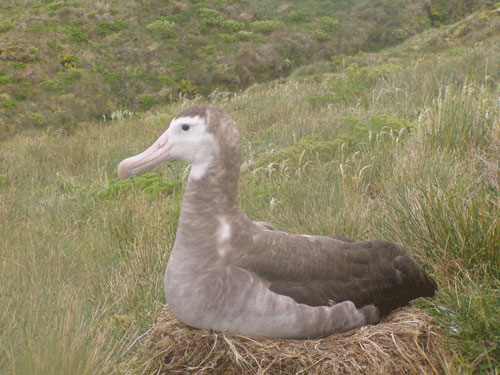Jeffrey Dawson (RSPB Centre for Conservation Science, Royal Society for the Protection of Birds, Sandy, United Kingdom) and colleagues have published in the journal Conservation Biology on prioritizing islands in the United Kingdom Overseas Territories for the eradication of invasive vertebrates. Gough Island (World Heritage home of the ACAP-listed and Critically Endangered Tristan Albatross Diomedea dabbenena attacked by introduced House Mice Mus musculus) scores as the highest priority of over 2000 islands in 11 separate territories.
Three other islands supporting ACAP-listed species fall within the top 25 prioritized islands for alien vertebrate eradications: the main island of Tristan da Cunha (6th), South Georgia (Islas Georgias del Sur)* (11th) and New Island, Falkland Islands (Islas Malvinas)* (16th).
The paper’s abstract follows:
“Invasive alien species are one of the primary threats to native biodiversity on islands worldwide. Consequently, eradicating invasive species from islands has become a mainstream conservation practice. Deciding which islands have the highest priority for eradication is of strategic importance to allocate limited resources to achieve maximum conservation benefit. Previous island prioritizations focused either on a narrow set of native species or on a small geographic area. We devised a prioritization approach that incorporates all threatened native terrestrial vertebrates and all invasive terrestrial vertebrates occurring on 11 U.K. overseas territories, which comprise over 2000 islands ranging from the sub-Antarctic to the tropics. Our approach includes eradication feasibility and distinguishes between the potential and realistic conservation value of an eradication, which reflects the benefit that would accrue following eradication of either all invasive species or only those species for which eradication techniques currently exist. We identified the top 25 priority islands for invasive species eradication that together would benefit extant populations of 155 native species including 45 globally threatened species. The 5 most valuable islands included the 2 World Heritage islands Gough (South Atlantic) and Henderson (South Pacific) that feature unique seabird colonies, and Anegada, Little Cayman, and Guana Island in the Caribbean that feature a unique reptile fauna. This prioritization can be rapidly repeated if new information or techniques become available, and the approach could be replicated elsewhere in the world.”

A female Tristan Albatross on its Gough nest, photograph by John Cooper
Reference:
Dawson, J., Oppel, S., Cuthbert, R.J., Holmes, N., Bird, J.P., Butchart, S.H.M., Spatz, D.R. & Tershy, B. 2014. Prioritizing islands for the eradication of invasive vertebrates in the United Kingdom Overseas Territories. Conservation Biology DOI: 10.1111/cobi.12347.
Click here and here for two popular articles on the published paper.
John Cooper, ACAP Information Officer, 14 September 2014

 English
English  Français
Français  Español
Español